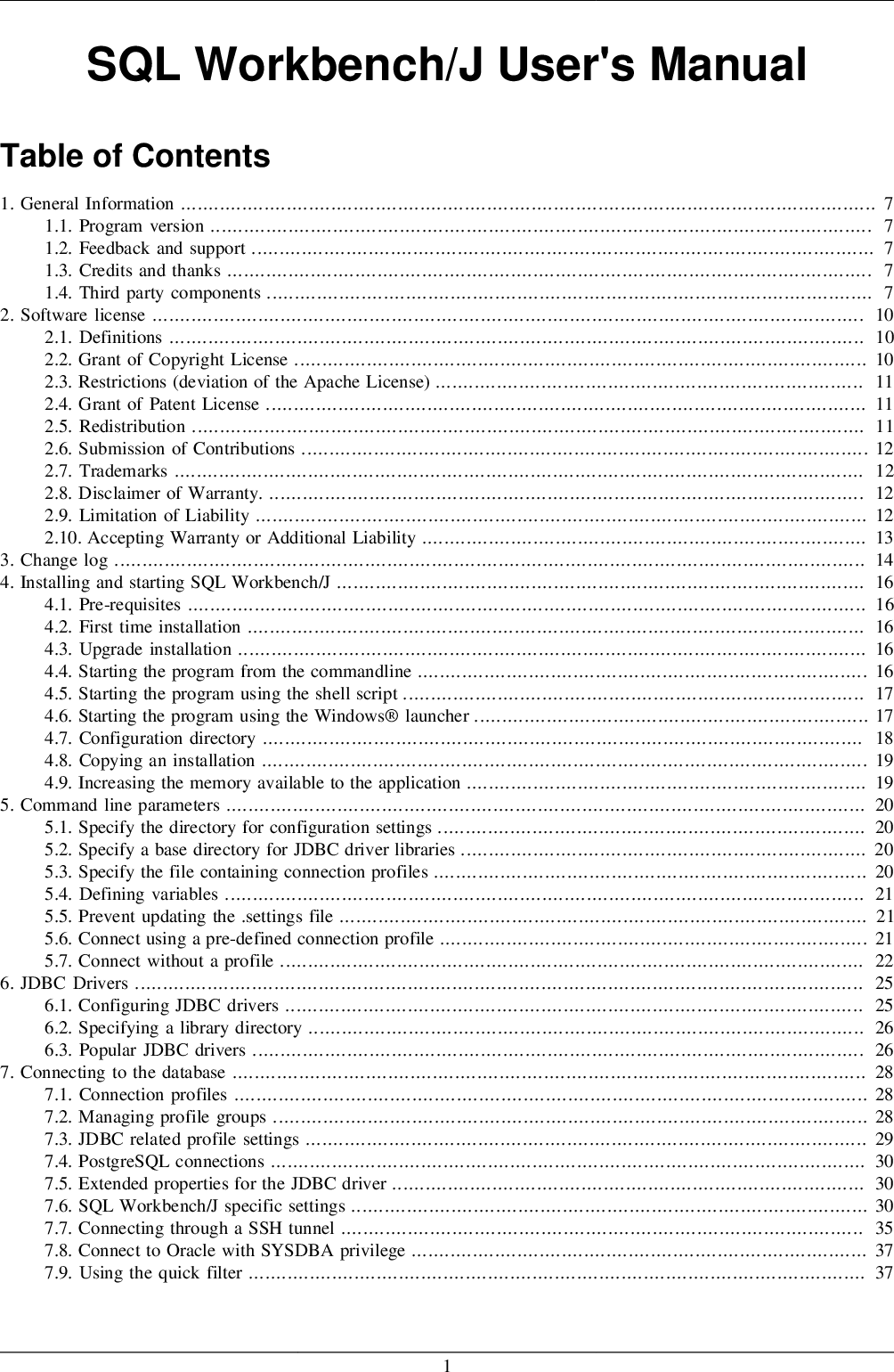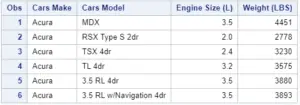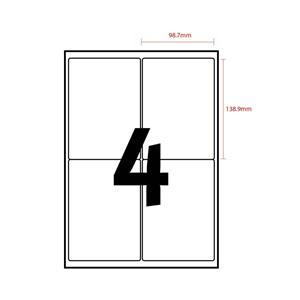41 proc print with labels
How to Label Variables in SAS - SAS Example Code You use the PROC DATASETS procedure in combination with the LABEL statement to assign a label to a variable in SAS. The syntax of the LABEL statement is straightforward. The LABEL keyword is followed by the name of the variable, an equal sign, and the label between quotes. With the code below we assign the label Student Name to the Student column. › 2015 › 08SAS : PROC TRANSPOSE with Examples - ListenData Aug 06, 2015 · The ID statement tells SAS to provide variable names to the variables after the transpose. But if you want to label these variables, you can use IDLABEL statement which picks labels from a variable from the input file. proc transpose data=temp out=outdata prefix=height; by id; var scores; id height; idlabel heightl; run;
SAS Help Center: LABEL Statement Some PROCs, such as PROC PRINT, can temporarily associate a label with a variable for use during the procedure. This example demonstrates the use of labels during the creation of a report. By using the PROC PRINT label option, you can display labels in place of variable names in the output report.

Proc print with labels
sasexamplecode.com › 5-ways-in-sas-to-calculate5 Ways in SAS to Calculate the Average per Group Dec 19, 2020 · If you execute PROC REPORT with just the DATA= statement, then SAS shows the input data on your screen. So, in this case, PROC REPORT and PROC PRINT give the same result. To calculate the average per group with PROC REPORT, you need to add the following statements. With the COLUMN statement, you specify the columns of the report. pdf - PROC PRINT ignoring LABEL statement - Stack Overflow 1 Answer. Sorted by: 2. Use the PROC statement LABEL in the opening line to tell PROC PRINT to use the labels. proc print data=work.table noobs label; label cnt_approved = 'Approved' total = 'Total' perc_approved = 'Percent Approved'; run; Share. libguides.library.kent.edu › SAS › FrequenciesFrequency Tables using PROC FREQ - Kent State University Jun 24, 2022 · This guide contains written and illustrated tutorials for the statistical software SAS. In SAS, the FREQ procedure can be used to analyze and summarize one or more categorical variables. In this tutorial, we focus on creating simple univariate frequency tables using PROC FREQ.
Proc print with labels. SAS Help Center It also uses labels as column headings. PROC PRINT breaks a column heading when it reaches the split character and continues the header on the next line. The split character is not part of the column heading although each occurrence of the split character counts toward the 256-character maximum for a label. Generating multiline axis labels in SAS PROC SGPLOT | SAS Code Fragments The changes we have made to our proc sgplot code are: Add the name of the annotation dataset to the sganno= option on the proc sgplot statement. Add 35 pixels of padding space to the bottom of the graph with the pad= option on the proc sgplot statement. Override the x-axis label proc sgplot will try to print by specifying nolabel in the display ... › pharmasug › 2006Simple Ways to Use PROC SQL and SAS DICTIONARY TABLES to ... The output will identify non-complying variables: those variables whose names or labels are too long, and those that do not have labels. Requirement #3: No user defined formats should be permanently associated with any variables in a data set. TITLE "Check if variables are associated with user-defined formats"; UMD Creating a Basic Report. To list the information in a SAS data set, you can use PROC PRINT. You use the PROC PRINT statement to invoke the PRINT procedure and to specify the data set that you are listing. Include the DATA= option to specify the data set that you are using. By default, PROC PRINT displays all observations and variables in the ...
communities.sas.com › t5 › SAS-ProgrammingSolved: proc sql - Creating lables - SAS Support Communities Jan 04, 2018 · i want to create labels for a dataset using proc sql. i used the code. proc sql; select PRODUCT_ID label="Line number" from a6.SMB; quit; but in the result the column name product_id is changed to line number. The PRINT Procedure : PROC PRINT Statement - SAS Note: PROC PRINT does not split labels of BY variables in the heading preceding each BY group even if you specify SPLIT=. Instead, PROC PRINT treats the split character as part of the label. Therefore, you probably want to avoid using a split character when you are using the BY statement. UNIFORM See WIDTH=UNIFORM . WIDTH=column-width PROC PRINT: PROC PRINT Statement - SAS It also uses labels as column headings. PROC PRINT breaks a column heading when it reaches the split character and continues the header on the next line. The split character is not part of the column heading although each occurrence of the split character counts toward the 256-character maximum for a label. SAS Help Center: Example: PROC PRINT Summing Numeric Variables with One ... label sale_type='Sale Type' price='Total Retail Price* in USD' country='Country' order_date='Date' quantity='Quantity'; Sum the values for the selected variables. The SUM statement alone sums the values of Price and Quantity for the entire data set. Because the PROC PRINT step contains a BY statement, the SUM statement also sums the values of ...
PROC PRINT: Customizing Text in Column Headings - SAS Data set: EXPREV. This example. customizes and underlines the text in column headings for variables. customizes the column heading for the column that identifies observations by number. shows the number of observations in the report. writes the values of the variable Price with dollar signs and periods. creates a default PDF report. 'label' Statement - Boston University When a label statement is placed in a data step, the label stays with the variable for all subsequent procedures, unless relabeled. When placed in a procedure the label only stays attached to the variable for that procedure. Use double quotes if there is to be a single quote in the label. For example, label mombp="mother's systolic bld pressure"; 6.7 - Descriptive Labels In order to label the columns in your report as such, you need to use: a LABEL statement to assign a descriptive label to a variable, and; the LABEL option in the PROC PRINT statement to specify that labels, rather than variable names, be displayed. The LABEL statement can be placed either in a DATA step or directly in the PRINT procedure. Viewing Data - SAS Tutorials - LibGuides at Kent State University In the first line of the SAS code above, PROC PRINT tells SAS to execute the print procedure on the dataset specified by the DATA= argument. Immediately following PROC PRINT is where you put any procedure-level options you want to include. Let's review some of the more common options: LABEL Print variable labels instead of variable names, if ...
proc GLM and labels - narkive proc print data=GLMout LABEL; run; Now try this: proc print data=GLMout ;run; Perhaps yuu need to be more specific. j***@gmail.com 2014-08-01 12:16:47 UTC. Permalink. What is asked about is how to get the label out on the orignal output. I have the exact same problem and where most proc's beside the variable name also put the label in the ...
51927 - New options in PROC PRINT to add summary row labels in SAS® 9.4 51927 - New options in PROC PRINT to add summary row labels in SAS® 9.4 Curiosity is our code. SAS analytics solutions transform data into intelligence, inspiring customers around the world to make bold new discoveries that drive progress. SAS gives you THE POWER TO KNOW®. Contact Us
communities.sas.com › t5 › SAS-Communities-LibraryGetting All Duplicates of a SAS Data Set - SAS Support ... Jan 29, 2015 · A simple PROC FREQ shows the frequency counts of each possible value of var1. proc freq data = test; tables var1 / nocum nocol norow nopercent; run; 111 1 222 1 333 1 444 3 555 2 666 3 777 1 888 2 999 3 Here is the WRONG way to get the duplicates from test. proc sort data = test nodupkey dupout = dups; by var1; run; proc print data = dups; run ...
Creating and Using Multilabel Formats - SAS Users Creating and Using Multilabel Formats. A multilabel format enables you to assign multiple labels to a value or a range of values. The capability to add multilabel formats was added to the FORMAT procedure in SAS® 8.2. You assign multiple labels by specifying the MULTILABEL option in the VALUE statement of PROC FORMAT.
Suppress variable labels in SAS procedures - The DO Loop In PROC PRINT you can use the LABEL option to display labels instead of variable names. Most analytical procedures (for example, regression procedures) always display variable names. If you have a procedure (such as PROC REG in this example) that displays both, you would have to modify the ODS template to suppress the column of variable names. ...
UMD proc print data=flights.laguardia label; id date; var boarded transferred flight; label boarded='On' transferred='Changed'; where flight='219'; run; d. proc print flights.laguardia noobs; id date; var date on changed flight; where flight='219'; run; Which of the following PROC PRINT steps is correct if labels are not stored with the data set? ...
SAS Help Center SAS® Help Center. Customer Support SAS Documentation. SAS® 9.4 and SAS® Viya® 3.5 Programming Documentation. |. SAS 9.4 / Viya 3.5. PDF EPUB Feedback. Welcome to SAS Programming Documentation for SAS® 9.4 and SAS® Viya® 3.5. What's New. Syntax Quick Links.
Solved: proc print display label - SAS Support Communities Either the LABEL or the SPLIT option tells PROC PRINT to use the LABEL for the data. cynthia 0 Likes Get ready to reserve your seat! Call for content is closed. Registration opens in July. Learn more. 5 Ways to Make Your SAS Code Run Faster. Get tips to run SAS code faster by comparing things like KEEP/DROP vs. KEEP=/DROP=, WHERE vs. IF, SQL vs ...

ProCon Labels | We manufacture and stock a wide variety of self adhesive labels. Various sizes ...
SAS Help Center: Example: PROC PRINT Creating a Customized Layout with ... Assign labels to the appropriate variables. The LABEL statement associates a label with each variable for the duration of the PROC PRINT step. When you use SPLIT= in the PROC PRINT statement, the procedure uses labels for column headings. label jobcode='Job Code' gender='Gender' salary='Annual Salary'; Create formatted columns.
PDF PROC PRINT - the Granddaddy of all Procedures, Enhanced and Still Going ... PROC PRINT can trace its lineage back to the first version of SAS to be commercially released. In recent years, with the advent of PROC REPORT and the ODS system, the PRINT procedure has been pushed to the back of the reporting procedures to where it is considered as no more than being able to do a basic data dump. However, PROC PRINT has been
PROC PRINT: Examples: PRINT Procedure - SAS Examples: PRINT Procedure Example 1: Selecting Variables to Print Example 2: Customizing Text in Column Headings Example 3: Creating Separate Sections of a Report for Groups of Observations Example 4: Summing Numeric Variables with One BY Group Example 5: Summing Numeric Variables with Multiple BY Variables
Proc Format In SAS - 9TO5SAS The PROC FORMAT to assign ...
4 Little Tricks To Achieve The Best Results In PROC PRINT SAS. Below are some of the things that you can do with PRINT that may make even this standard procedure extra helpful. 1. Using the ID and BY Statements in PROC PRINT 2. Using the STYLE= Option with PROC PRINT 3. Using PROC PRINT to Generate a Table of Contents 4. Generating Column Totals 1. Using the ID and BY Statements in PROC PRINT
PROC PRINT :: Base SAS(R) 9.3 Procedures Guide, Second Edition PROC PRINT sometimes conserves space by splitting labels across multiple lines. Use SPLIT= in the PROC PRINT statement to control where these splits occur. You do not need to use LABEL if you use SPLIT=. Note: The SAS system option LABEL must be in effect in order for any procedure to use labels.
infolab.stanford.edu › ~ullman › fcdbIntroduction to Pro*C - Stanford University Code emission by precompiler. To get C++ code, you need to set the option CODE=CPP while executing proc. C users need not worry about this option; the default caters to their needs. Parsing capability. The PARSE option of proc may take the following values: PARSE=NONE. C preprocessor directives are understood only inside a declare section, and ...
libguides.library.kent.edu › SAS › FrequenciesFrequency Tables using PROC FREQ - Kent State University Jun 24, 2022 · This guide contains written and illustrated tutorials for the statistical software SAS. In SAS, the FREQ procedure can be used to analyze and summarize one or more categorical variables. In this tutorial, we focus on creating simple univariate frequency tables using PROC FREQ.
pdf - PROC PRINT ignoring LABEL statement - Stack Overflow 1 Answer. Sorted by: 2. Use the PROC statement LABEL in the opening line to tell PROC PRINT to use the labels. proc print data=work.table noobs label; label cnt_approved = 'Approved' total = 'Total' perc_approved = 'Percent Approved'; run; Share.
sasexamplecode.com › 5-ways-in-sas-to-calculate5 Ways in SAS to Calculate the Average per Group Dec 19, 2020 · If you execute PROC REPORT with just the DATA= statement, then SAS shows the input data on your screen. So, in this case, PROC REPORT and PROC PRINT give the same result. To calculate the average per group with PROC REPORT, you need to add the following statements. With the COLUMN statement, you specify the columns of the report.










Post a Comment for "41 proc print with labels"